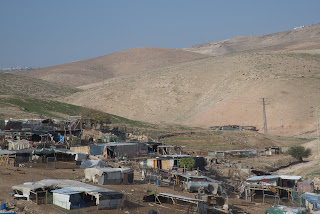We arose early to attend a bible devotional session with
Sean in a meeting room next to a synagogue all within the hotel bomb shelter.
Following breakfast we are on the bus at 8:30 am on our way to the Dead Sea. On
the way we drove past a quarry from Jesus time where stone dishes were made.
Also off in the distance was an area where Jesus raised Lazarus from the dead. Next
we drove through one of the Israeli settlements on the West Bank, which
supports about 100,000 Israelis. Lior, our guide, gave a good explanation as to
why the Palestinian Israeli reconciliation issues are so difficult. This
settlement was in Zone C, one of three zones in the West Bank, where Israeli security
and Israeli governance applies. Around this settlement are two other zones,
Zone B where Israeli security and Palestinian governance applies, and Zone A
where Palestinian security and Palestinian governance applies. 50% of the West
Bank areas are in zones A and B and 50% in zone C. We learned a great deal
about the complexity of issues in this region from both the Israeli and
Palestinian perspectives. Both groups lay claim to the same land based upon
their religious or biblical history. Security is a critical issue in light of
Palestinian missiles fired from the Gaza Strip during our visit, which prompted
Israeli retaliation. Lior indicated that
education and trust together with an end to the hatred are the key ingredients
to a lasting reconciliation. This appears to be more important at the people to
people level than at the political level, although strong leadership is
necessary on both sides to facilitate the reconciliation. Lior opined that
third parties forcing negotiations will not work. We all pray for resolution to
the conflict and reconciliation between the Israeli and Palestinian people.
We stopped
at En Gedi after passing through the West Bank checkpoint. En Gedi is a lush
oasis with Acacia trees and a waterfall that flows from the mountain areas. We
were intrigued by the Ibex, wild goats which can climb trees to get away from
their predators. En Gedi is the place where David spared Saul after he cut off
a corner of his cloak and was “stricken to the heart”, I Samuel 24:1-13.
We then
headed to Masada, an enormous fortress and palace built by King Herod in 1st
century BC on a 1,400 foot plateau as a refuge from his enemies. As we rode the
cable car up the cliffs to the entrance, we thought about how complex it was to
build and how many slaves were needed to bring up the supplies for this
gigantic structure. Once at the entrance, we were only at sea level with
dramatic views of the Dead Sea. Elaborate
structures were built on the 1,000 square foot plateau. El’azar was the leader
of the zealot group, which began the Jewish Revolt in 66 AD, and took Masada
from the Romans. A few years later Roman
legions came to recover control of the lands. The zealot group was the last of
the Jewish resistance who took refuge at Masada. In recognition of the zealot
group’s impending annihilation by the Roman legions about to attack, the zealot
group drew lots to decide which men would kill the others to keep their
families from being murdered or enslaved. As Christians, we are challenged to ask what
we can learn from the people of Masada.
Leaving
Masada, we went to the Dead Sea for a swim, which was really floating on our
backs to avoid heavily salted water on our faces. Since John and Kay Norvell,
our professional photographers, covered themselves with therapeutic mud and went
swimming, photos were courtesy of Ed Tennent.
Our last
stop was at the Ahava skin care factory where we sampled the products and
shopped.
Bob Stow, Sherry and Gregg Johnson




































The entire PPC family continues to enjoy your reflections. It is a particular blessing to hear from different perspectives each day. We pray that your final day in the Holy Lands is fulfilling and that you travel home safely. We are keeping some snow and chilly weather around to greet you upon your return.
ReplyDeleteBlessings,
Pastor Kendra